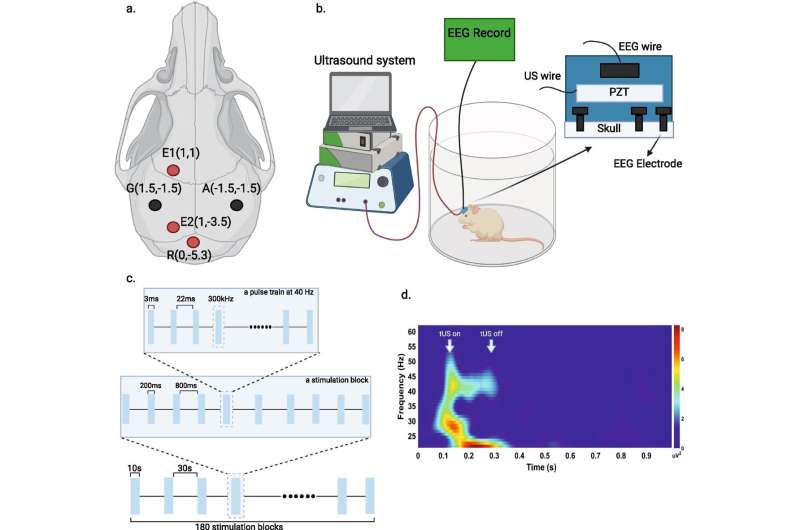Experiment protocol. (a) EEG electrode positions for surgical implantation. E1 and E2 indicate electrodes on the frontal and parietal cortex, respectively, while reference electrode (R) was placed on cerebellum. G and A correspond to the electrodes for animal grounding and the anchoring screw, respectively. Red dots denote the location of implants for EEG signal generation; black dots represent implants generating no signal. (b) tUS and EEG recording device setup. A piezo-ceramic transducer (PZT) with two connecting wires was placed on top of the head-mount layer, which included an EEG electrode and was attached with dental cement. (c) Ultrasound parameter protocol. A 3-ms ultrasound pulse train at 300 kHz was followed by a 22-ms intervening period to make a carrier frequency of 40 Hz. A 10-s stimulation block followed by a 30-s resting period was repeated 180 times. (d) Time–frequency analysis of EEG power generated by a tUS stimulation block. A representative figure demonstrates that the EEG power was increased at 40 Hz during the tUS stimulation. Credit: DOI: 10.1186/s40035-021-00274-x
In December 2021 scientists from South Korea used a technology called transcranial ultrasound stimulation to excite specific areas of mice brain. They found mice with features of Alzheimer's had reduced levels of the hallmark Alzheimer's protein, amyloid after receiving treatment.
Researchers used a low frequency at 40Hz to stimulate the brains of mice bred to have features of Alzheimer's disease. Alzheimer's is the most common cause of dementia worldwide.
The mice had electrodes implanted into the skull to receive the treatment designed to stimulate brain waves.
Dr. James Connell, head of translational science from Alzheimer's Research UK, said, "Unless we act, one in three people born today will go on to develop dementia. There are currently no treatments that can affect the course of the diseases that cause this devastating condition in the UK. The development of new treatments and technologies is an important focus for research to overcome diseases like Alzheimer's and it's important to explore as many avenues as possible.
"In this study researchers tested whether low frequency ultrasound treatment to activate electrical brain impulses in mice bred to have features of Alzheimer's improved brain health. Although researchers noticed some changes in the level of the hallmark Alzheimer's protein, amyloid, as well as changes in brain activity in the mice receiving stimulation, the study does not provide enough evidence to suggest any benefit from this treatment.
"Further robust and reproducible research is needed before meaningful conclusions can be drawn. As with any research involving mice the only way to know if these findings are relevant to help treat people is through further studies in people."
More information: Mincheol Park et al, Effects of transcranial ultrasound stimulation pulsed at 40 Hz on Aβ plaques and brain rhythms in 5×FAD mice, Translational Neurodegeneration (2021). DOI: 10.1186/s40035-021-00274-x
Provided by Alzheimer's Research UK























